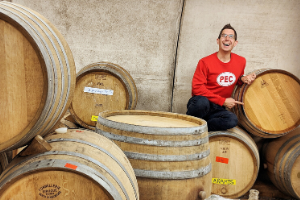Discover two cidermaking techniques that are also used in winemaking, called Maderisation and Bâtonnage. We delve into both of these topics in Part 3 of the Quarantine Quad Series called “Ask Ryan” with Ryan Monkman of FieldBird Cider, Ontario Canada answering questions from Cider Chat listeners.
Maderisation: What is this technique and can it be used with cider?
Bâtonnage: are there any short term benefits from bâtonnage or does one need to “stir up the barrel” for a long period (1 year at the least) to benefit from this technique?
Listen Part 1 and Part 2 of the Quarantine Quad Series.
Ask Ryan begins at 14:41 minutes into this episode
Maderisation – The barrels are cooked – sometimes for years. Developing flavors called “maderised”.
- If done well it can be delicious.
- High alcohol cider is best for maderisation – slower bacterial growth. Cider that is has a low alcohol by volume – likely to get organism spikes.
FieldBird is planning to do a maderized cider from the 2020 harvest
- Northern Spy, fermented half way and fortified with apple brandy and let the barrel sit in a hot place.
- 17 Brix on the Spys (9%) ferment down half way and then add brandy. Getting 8% sugar.
- Sugar helps – creates the caramel flavor and provides an appearance of freshness.
- No MLF in the presence of sugar. Leave in cellar over the winter.
- Then leave the barrel outside all summer.
- 30 Celsius – 86 Farenheit.
- This will cause the maderisation
The risk of maderisation is cooking a barrel to much
The final product will be around 17-18%
Battonage: Is it worth it if you don’t have a full year to do Bâtonnage on a barrel?
- Nano proteins are the biggest benefit of Bâtonnage
- They release into the cider providing a perception of sweetness and body with out the sugar
- Need at least 9 months to a year to get the nano proteins
There are short term benefits.
- Yeast produces less carbon dioxide and bubbles.
- They slow down after the first primary ferment.
- Fermentation may have stopped but there is still sugar left.
- Lees absorb off aromas, except for H2S rotting egg smell.
- Bâtonnage helps to maintain a reductive state.
- Full reduction – rotting smell is a type of reduction. Which helps protect the cider from oxidization and protect the flavor components.
In wine, a Sauvignon Blanc, has rich tropical flavors which come from a rich reductive state,
At FieldBird, they save lees in the freezer.
Cracking – the freeze helps the lees cells break down.
- Using frozen lees that have cracked – means it will takes only 4-5 months versus 8-9 months in the barrel to get the benefits from Bâtonnage
Contact for Ryan Monkman at FieldBird Cider
- website: https://www.fieldbird.ca/
- Instagram
- FieldBird https://www.instagram.com/fieldbird.cider/
- Ryan Monkman https://www.instagram.com/rgmonkman/
Mentions in this chat
Help Support Cider Chat Please donate today. Help keep the chat thriving!
Find this episode and all episodes at the page for Cider Chat’s podcasts.
- Listen also at iTunes, Google Play, Stitcher (for Android), iHeartRadio , Spotify and wherever you love to listen to podcasts.
- Follow on Cider Chat’s blog, social media and podcast
- Twitter @ciderchat
- Instagram: @ciderchatciderville
- Cider Chat FaceBook Page
- Cider Chat YouTube
Haven’t downloaded this episode yet? Here it is again for your listening pleasure.



